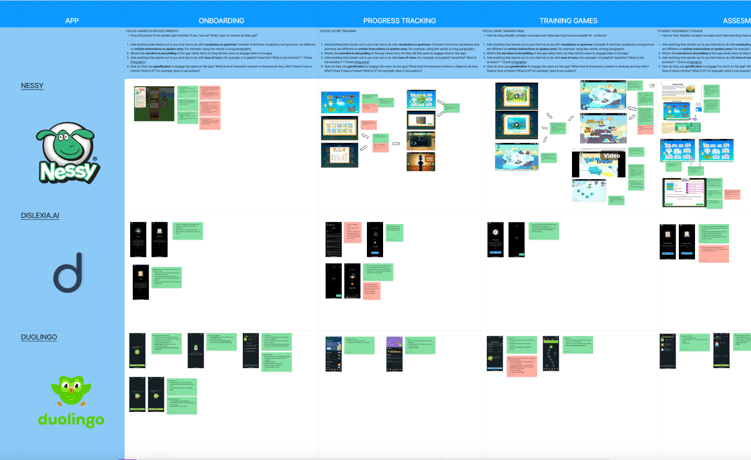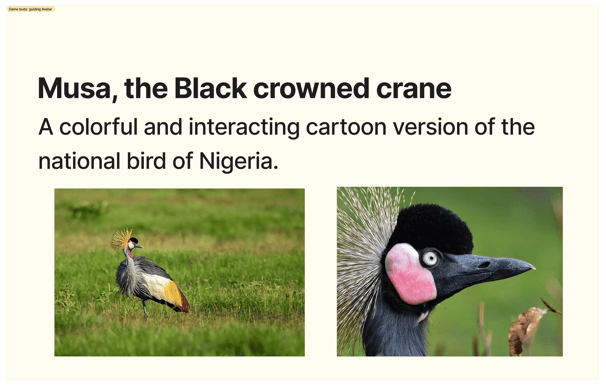
Dyslexia Project
It is a desktop app focused on cognitive and literacy training of children with dyslexia.
The product is primarily addressed to children in Nigeria and West Africa, as it's been designed in collaboration with the Dyslexia Foundation of Nigeria.
The second objective is raising awareness among the population (especially parents and teachers) to promote destigmatization.
Achievements
Research on the language and social context of children with dyslexia in Nigeria.
Information Architecture Design.
Localization, creation of a narrative adapted to the context of the users.
Microcopy for onboarding, dashboard, and cognitive game flows.
Creation of a style guide.
Indice
English
Language


Problem
In West Africa, dyslexia - which is a learning disorder that involves difficulty reading and writing - is widely misunderstood and carries a big social stigma.
This is a huge challenge for the education system: 20% of Nigerians struggle with dyslexia, yet around 90% of Nigerian teachers lack the necessary knowledge and awareness about this disorder. Therefore it's a struggle to provide appropriate support and accommodations for dyslexic people within the education system.
Raising awareness to address this issue is essential to ensure that all students have equal opportunities to excel academically.
Case setup
Although the age range of people with dyslexia that can benefit from this application is quite wide, at this stage, the team, led by Product Management and advised by the Dyslexia Foundation of Nigeria, decided to focus the product on children and teenagers aged 7-16 years.
Target audience
Team setup
The application has two user flows: one for teachers and one for students. This case study follows the process of the UX writing team on the student side.
We worked cross-functionally with the UX research, UX design, strategy, and product management teams.
My role
As Lead UX Writer, I led a team of 2 UX Writers during the whole process. For a short period of time, due to product needs, I also guided the teacher flow team, a total of 5 people.
The Dyslexia Foundation of Nigeria
It is a foundation committed to raising awareness, identifying disorders and training for learning challenges (especially dyslexia). They pioneered the first and only full assessment and diagnosis of dyslexia in Nigeria; it has been at the forefront in the treatment of dyslexia by providing training and resources for people with dyslexia, teachers, parents and other education stakeholders.
Research
To fully understand the users and assess their relationship with reading, we focused on the use of language and the best grammar guidelines for children with dyslexia. We wanted to understand which words, idioms or grammatical structures work best for them and which should be avoided.
We also researched the social and cultural context of people with dyslexia in Nigeria. We needed to understand what challenges they face and how to help them overcome them.
Here are some of the things we discovered:
Best practices for writing content for people with dyslexia: active voice, shorter texts, use of visuals, etc.
Nigerians place a high value on academic results.
It is very common to use loanwords and idioms from other languages (English is not the only official language in the country).
Religion is of significant importance in Nigeria, which can result in the emergence of myths, stigma and denial related to dyslexia.
Teachers are overworked and have little knowledge about dyslexia.
User research
Benchmark
We analyzed apps related to Dyslexia and/or education, focusing on the use of English, storytelling, tone of voice, and gamification. First, we decided which features/aspects we needed to analyze and which existing apps would give us the best insight into the main features/aspects that our MVP would have.
Anything to do with vocabulary or grammar. We considered whether and how vocabulary and grammar are different in written and spoken instructions. For example: using few words versus long paragraphs.
What is the narrative and storytelling of the application (what story do they tell users to engage them in the application)?
Tone of voice. For example: Is it fun, is it assertive, what is the emotion?
The use of gamification to engage users in the app. What kind of content or interactive features does it offer? Does it have a theme? What is it? For example: does it use avatars?
How do they simplify complex concepts and make learning more accessible to students?
Are the student's parents included? If so, what does that look like, and what kind of content do they get?
We then conducted an in-depth analysis of Nessy, Dyslexia.ai, and Duolingo.
And we came to the following conclusions:
Shorter sentences, breaking up longer paragraphs into bullet points.
General positive and practical tone. Becomes playful during onboarding and games.
Many sentences start with a short verb, leading the user to perform a clear action.
The language is direct, easy, and clear. With active voice.
Images and videos are used to explain more complicated concepts, such as the onboarding for the game. Images also reinforce engagement.


Information architecture
In collaboration with the UX Design team, we made a list of all the features the app could have, then prioritized them and prepared a card sorting test to decide which ones to keep and how to organize them.
Due to the time constraints of the project and the difficulty of reaching Nigerian children with dyslexia - we also considered talking to their parents but due to the stigma it was still too difficult to reach them and gain their trust in time-, therefore, we were not able to test with users.
However, we needed to start defining an Information Architecture, so we decided to assume that we would be working on assumptions from this point on, and everything will have to be tested during the next phase of the project. At least we wanted to give the next teams a base from which to start.
We defined three main features:
the onboarding
the dashboard
the cognitive training game
In the image below you can see in medium blue the elements that we considered essential for the MVP, and in light blue the ones that would be nice to include, if we had the time.
Once the sitemap was defined, the UX Design team could start ideating and designing. Throughout the process the original sitemap was modified several times as we found new demands during the wireframe design work.


Localization and narrative
The research findings pointed to a high stigma surrounding dyslexia, which led to children feeling excluded, frustrated and experiencing low self-esteem. This resulted in an alarming school drop-out rate.
Therefore, we needed to motivate users by making them feel valued. I decided to conduct a new Desk Research to find local referents and elements they could identify with. We collected information on famous cartoons, folk stories, landscapes, native Nigerian animals and some celebrities with dyslexia (such as Einstein or Agatha Christie).
The results inspired the narrative we came up with.
Localization
Narrative
We started by defining the vision, mission, and core values of the product. And then we thought of ways to translate them into the design, making it relatable, attractive, and familiar to users.
The story that guides them through the app is a magical adventure on Lake Chad. The child -who can choose an avatar to represent him- must help his guide -Musa, the black crowned crane, which is both the most popular name in Nigeria and the national bird- to complete a collection of all the animals of Nigeria. On his journey, they will encounter local animals and experience exciting challenges.
In each level of the game, the child will have to read about a specific animal. Each time they complete a challenge, they will get a badge related to the new information they have learned about the animal's habits, favorite food, favorite dance, etc. Once they complete all the challenges in that Game Level, they will get a photo of their own avatar with the animal, which will be added to the photo album they are creating.
The story motivates the child to progress and, with each level, they will learn more words and improve their reading skills.




Voice and tone
If the app were a person, they would be friendly, encouraging, and patient. If we were to sit down for a coffee with them we would discover that they are trustworthy, want the best for us, and have expert knowledge of what they do. They also have a sense of humor, but it is respectful, positive, and supportive - and should only be used when necessary-.
The overall tone is conversational, respectful, and practical, as the main priority is to be readable and accessible to children with dyslexia. However, we define some differences in each functionality:
In the onboarding, the tone is neutral, direct, conversational, and friendly. At certain moments it can also be fun - this should be consistent with the context and the user's journey-. The priority is to inform the user how to complete a task in a clear and direct way.
On the Home Panel, the tone is practical, respectful and conversational. The priority is clarity and simplicity, the user must be able to understand where each feature is and what each feature is for.
The tone of the games is practical, encouraging, fun and informative. The aim should be to maintain a supportive and encouraging atmosphere throughout the application. So that users know that it is OK to take their time. In this case, it is allowed to use jokes, puns, rhymes and funny sounds or pictures to create a fun atmosphere and help users enjoy the games and activities. It is recommended to break the information into shorter sentences using simple and precise language, examples and diagrams.


Style guide
All of this information, along with specific language and grammatical guidelines, accessibility and localisation tips, and do's and don'ts by function, are compiled in a Content Style Guide which you can access here.
UX Writing
This is the first contact the child will have with our product, they have probably used other apps before, have done hundreds of dyslexia training exercises and are already frustrated and bored with them. Therefore, our product had to be different, relatable, fun and motivating. This is their safe space.
Our priority was to introduce narrative and reinforce the playfulness and gamification aspect of the app:
We used words like "explorer", "adventure" or "challenges".
Hi explorer, it's great to have you here! My name is Musa, I'm going to be your guide in this adventure you are about to start! Oh, I'm so excited, I hope you are too!
We explain everything with simple words, short sentences and a very positive and motivating tone.
You see, there are so many animals in this lake and yet many people don’t know them!
I have been trying to complete an album to show them around but they won’t stay still. There’s only one way to get a good picture of the animals: you must complete all the challenges and earn their trust!
Will you help me? I know we can make it together!
We made sure to make the actions very clear so that the user knows how to proceed.
Your first two tasks are: Tell me what’s your name. Could you write it down so I won’t forget?
And the second one is to choose your Avatar’s look. This means you can choose a picture that shows how you would look like as an explorer. That way all the animals will recognize you!
Sounds fun, right? Click the “Let’s get ready” button at the bottom of this page to start!
We changed the concept of "reading, spelling and maths" to make it more engaging and detach it from your usual school work.
Each challenge consists of different tasks like playing with letters, making words, finding numbers, or making a puzzle!
And guess what? Every challenge you complete earns you a cool badge!
We included a famous person with Dyslexia as a role model for you to look up to.
I know it’s going to be so much fun! I wish I could play myself but I’m just a bird, I’m not Einstein!
Fun fact: Did you know that Einstein was diagnosed with Dyslexia? He also loved playing with letters and numbers.
Onboarding
Dashboard
In this case the main objective was to make it very clear and easy to use. Let's remember that this is aimed at children from the age of 7, who also struggle with Dyslexia. Therefore, everything should be very visual, the information should be well structured and the language should be short and clear.
I modified the structure in the sidebar menu, considering that the most used tabs - Home, Games, Progress - should be placed at the top.
I also suggested changing the points earned to badges earned, as they are more visual and less stressful for users to read.




Cognitive training game
Cognitive Training Games are the core functionality of the application. They should be engaging and fun. Furthermore, they should be able to motivate users to go beyond their comfort zone and remind them that they are not alone in this learning process.
Although children will play these games either in the classroom or at home, and there will always be an adult present to supervise, we have also provided additional guidance from Musa to prepare children to play independently and increase their self-esteem. We explain this in the game's introductory video:
Do you need some help? That’s okay, I will be right here guiding you!
Don’t forget to have fun and take your time. You're in control!
During the games, there is very little text but we include some error messages, with a closing message to encourage you to try again.
